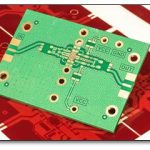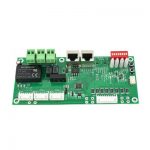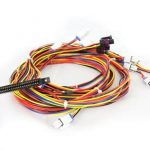Understanding Track width
Track width, also known as trace width, refers to the physical width of the copper tracks or traces on a PCB. These tracks are responsible for carrying electrical signals and power between components on the board. The width of the tracks is typically measured in mils (thousandths of an inch) or millimeters.
Factors Affecting Track Width
Several factors influence the choice of track width in PCB design:
- Current Carrying Capacity
- Signal Integrity
- Manufacturing Constraints
- PCB Layer and Thickness
- Temperature and Environment
Let’s explore each of these factors in more detail.
Current Carrying Capacity
One of the primary considerations when determining track width is the current carrying capacity. The track must be wide enough to handle the expected current flow without excessive heating or potential damage.
Current Density and Cross-Sectional Area
The current carrying capacity of a track is determined by its cross-sectional area and the maximum allowable current density. Current density is expressed in amperes per square mil (A/sq. mil) or amperes per square millimeter (A/mm²).
The cross-sectional area of a track is calculated by multiplying its width by its thickness. Increasing either the width or thickness of the track enhances its current carrying capacity.
IPC-2221 Standards
The IPC-2221 standard provides guidelines for determining the appropriate track width based on the expected current and temperature rise. The standard offers charts and formulas to calculate the minimum track width required for a given current.
Here’s an example table from IPC-2221 showing the current carrying capacity for various track widths:
| Track Width (mils) | Current Capacity (A) |
|---|---|
| 10 | 0.5 |
| 20 | 1.0 |
| 30 | 1.5 |
| 40 | 2.0 |
| 50 | 2.5 |
It’s essential to follow these guidelines to ensure the tracks can handle the required current without overheating or causing reliability issues.
Signal Integrity
Track width also plays a significant role in maintaining signal integrity on a PCB. Proper track width helps minimize signal distortion, crosstalk, and electromagnetic interference (EMI).
Impedance Control
In high-speed digital circuits, controlling the impedance of the tracks is crucial for maintaining signal integrity. The Characteristic Impedance of a track depends on its width, thickness, and the properties of the dielectric material.
To achieve the desired impedance, designers must carefully choose the appropriate track width and spacing. Commonly used impedance values include 50 ohms for single-ended signals and 100 ohms for differential pairs.
Crosstalk and EMI
Crosstalk occurs when signals from adjacent tracks interfere with each other, leading to signal distortion and errors. Adequate spacing between tracks and the use of ground planes can help mitigate crosstalk.
EMI is another concern in PCB design. Proper track width and routing techniques can help minimize EMI emissions and ensure compliance with electromagnetic compatibility (EMC) regulations.

Manufacturing Constraints
Track width also impacts the manufacturability of a PCB. Manufacturers have specific capabilities and limitations when it comes to producing tracks of different widths.
Minimum Track Width
Each PCB Manufacturer has a minimum track width they can reliably produce. This minimum width depends on the manufacturing process, equipment, and the overall capabilities of the facility.
Designers must ensure that the chosen track widths are within the manufacturer’s capabilities to avoid production issues and potential delays.
Aspect Ratio
The aspect ratio of a track refers to the ratio of its thickness to its width. Manufacturers have limitations on the maximum aspect ratio they can achieve.
Exceeding the maximum aspect ratio can lead to issues such as track lifting or peeling during the manufacturing process. It’s crucial to consider the aspect ratio when selecting track widths and thicknesses.
PCB Layer and Thickness
The choice of track width is also influenced by the number of layers in the PCB and the thickness of the copper.
Multi-layer PCBs
In multi-layer PCBs, the track width can vary depending on the layer. Inner layers often have narrower tracks compared to outer layers due to the limited space available.
Designers must carefully plan the track widths on each layer to ensure proper current carrying capacity and signal integrity while adhering to manufacturing constraints.
Copper Thickness
The thickness of the copper on the PCB also affects the track width. Thicker copper allows for narrower tracks while maintaining the required current carrying capacity.
However, increasing the copper thickness also impacts the overall cost and weight of the PCB. Designers must strike a balance between track width, copper thickness, and other design considerations.
Temperature and Environment
The operating temperature and environment of the PCB also influence the choice of track width.
Temperature Rise
As current flows through the tracks, it generates heat due to the resistance of the copper. The temperature rise of the track depends on factors such as the current density, ambient temperature, and the thermal properties of the PCB materials.
Designers must ensure that the track width is sufficient to dissipate the generated heat and prevent excessive temperature rise, which can lead to reliability issues and potential failures.
Environmental Factors
The environment in which the PCB will operate also plays a role in determining the track width. Factors such as humidity, vibration, and exposure to corrosive substances can impact the reliability of the tracks.
In harsh environments, designers may need to increase the track width to provide additional robustness and protection against environmental stresses.
Frequently Asked Questions (FAQ)
- What is the minimum track width I can use on my PCB?
-
The minimum track width depends on the capabilities of your PCB manufacturer. It’s essential to consult with your manufacturer to determine their minimum track width specifications.
-
How do I calculate the appropriate track width for a given current?
-
You can use the IPC-2221 standard, which provides charts and formulas to calculate the minimum track width based on the expected current and temperature rise. Alternatively, many PCB design software tools have built-in calculators to assist with track width selection.
-
Can I use different track widths on the same PCB?
-
Yes, it’s common to use different track widths on a single PCB. The track width can vary depending on the current requirements, signal integrity considerations, and the specific layer of the PCB.
-
What happens if I use a track width that is too narrow?
-
Using a track width that is too narrow can lead to several issues, such as excessive heating, insufficient current carrying capacity, and potential reliability problems. It’s crucial to choose track widths that are appropriate for the expected current and adhere to manufacturing constraints.
-
How does the choice of PCB material affect track width?
- The choice of PCB material can impact the track width in terms of the Dielectric Constant and thermal properties. Materials with higher dielectric constants may require wider tracks to maintain the desired impedance. Additionally, materials with better thermal conductivity can help dissipate heat more effectively, allowing for narrower tracks.
Conclusion
Track width is a critical aspect of PCB design that directly impacts the performance, reliability, and manufacturability of electronic devices. Choosing the appropriate track width involves considering factors such as current carrying capacity, signal integrity, manufacturing constraints, PCB Layers and thickness, and operating temperature and environment.
By understanding the importance of track width and following industry standards and guidelines, designers can create PCBs that meet the required specifications while ensuring optimal performance and reliability.
Remember to collaborate closely with your PCB manufacturer to ensure that your design adheres to their capabilities and constraints. With careful planning and attention to track width, you can create robust and efficient PCBs that power the electronic devices of today and tomorrow.






Leave a Reply